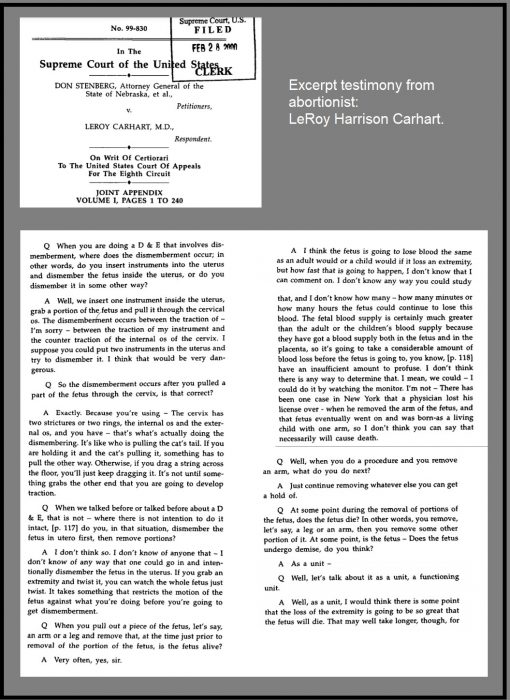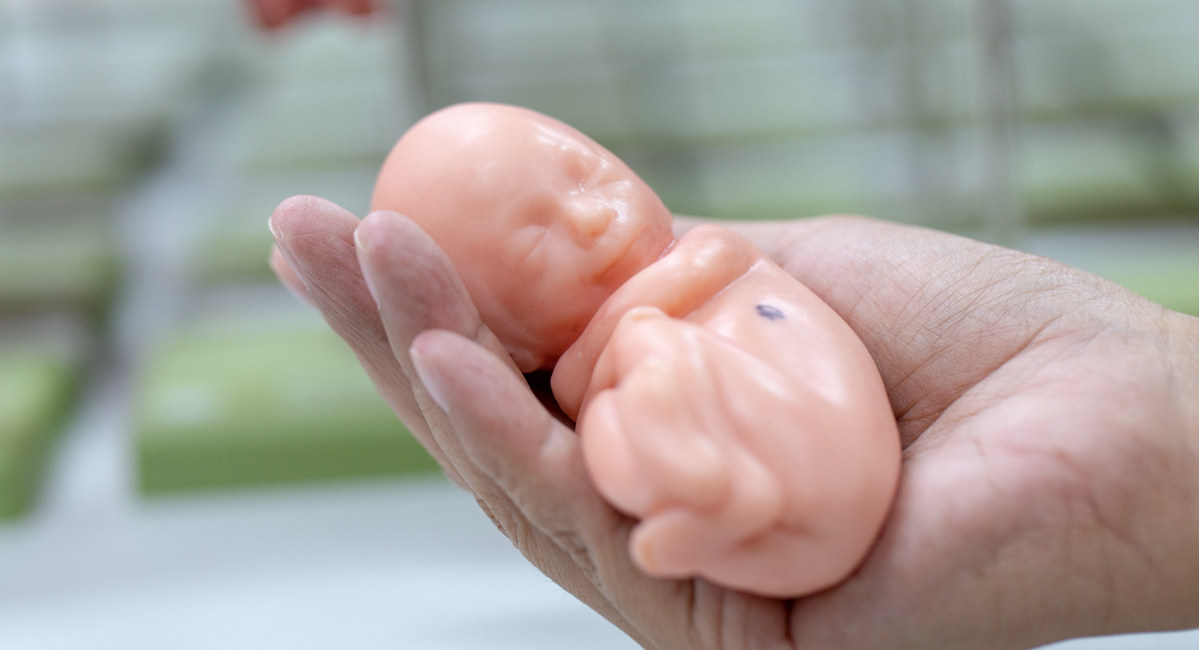An abortionist’s testimony describing a D&E or Dilation and Evacuation abortion (sometimes referred to as “dismemberment abortion”) reveals that this common second trimester elective abortion procedure is truly barbaric. This procedure is what Mississippi has sought to end with its controversial 15-week abortion ban — a ban soon to be brought before the U.S. Supreme Court to determine its constitutionality.
A suction aspiration abortion, according to Planned Parenthood, is typically the procedure used until 14-16 weeks gestational age (12-14 weeks after fertilization). But in the second trimester, a D&E is used, and unless a feticide is injected into the child’s heart to end his life (typically not used until closer to 20 weeks or later), the child would still be alive and is likely to feel pain while he is dismembered.
In the Stenberg v. Carhart case, which was heard before the U.S. Supreme Court years ago, late-term abortionist LeRoy Carhart described late-term abortion procedures. His testimony is raw and gruesome, revealing the horrific truth about what happens to a child during an abortion. The focus of Stenberg was Nebraska’s ban on “partial-birth” abortion (medically known as a D&X or intact D&E), but testimony transcribed in the joint appendix for the case details both D&E and D&X abortion procedures.

Abortionist’s testimony on dismemberment abortion (Dilation and Evacuation) or D+E described by abortionist LeRoy Carhart
“A tray full of pieces”: How dismemberment is done
Q: “Are there times when you don’t remove the fetus intact?”
Carhart: “… when you rupture the waters, usually something prolapses through the uterine, through the cervical os, not always, but very often an extremity will…. My normal course would be to dismember that extremity and then go back and try to take the fetus out either foot first or skull first, whatever end I can get to first.”
Q: “How do you go about dismembering that extremity?”
Carhart: “Just traction and rotation… grasping the portion that you can get ahold of which would be usually somewhere up the shaft of the exposed portion of the fetus, pulling down on it through the os, using the internal os as your counter-traction and rotating to dismember the shoulder or the hip or whatever it would be. Sometimes you will get one leg and you can’t get the other leg out.”
Q: “What happens next after you remove the arm? You then try to remove the rest of the fetus?”
Carhart: “Then I would go back and attempt to either bring the feet down or bring the skull down, or even sometimes you bring the other arm down and remove that also and then get the feet down.”
Carhart later said that to dismember the preborn child, the abortionist must “continue removing whatever else you can get a hold of.” He added that “[…]when you do a dismemberment D&E, you have a tray full of pieces, and it’s impossible to take a total inventory to know that you’ve taken out all the tissue….” (emphasis added)
This process of dismemberment was confirmed by Dr. Phillip Stubblefield, an abortionist who was a witness for Carhart in the case. Stubblefield “offered D & E abortion through about 22 1/2 weeks of pregnancy.” He also taught others how to commit abortions and is said to have supervised “1,500, to 2,000 abortions a year.” Stubblefield testified:
Standard D&E is to have a predilated cervix with the laminaria [thin seaweed sticks which absorb moisture and gradually dilate the cervix], and then there is some variation as to what is done, but my procedure would be to insert a vacuum cannula, use that to rupture the membranes and drain the amniotic fluid, and rotate the cannula around. Sometimes that will actually begin to separate and pull out part of the placenta.
Sometimes a fetal part will come out, and then switch to the forceps, pull the cannula out and switch to the forceps, reach inside and gently grasp and turn, and then basically tear off pieces of the fetus and pull them out…
What one does is reach up, grasp what you can, and pull down, and that comes apart. The fetus separates and comes out when you do that.
Q: “What would be some examples of parts of the fetus that might be removed with forceps?”
Stubblefield: “Leg, arm.”
Preborn child still alive while dismembered
Q: “When you pull on the arm and remove it, is the fetus still alive?”
Carhart: “Yes.”
Carhart later acknowledged, “I know that the fetus is alive during the process most of the time because I can see fetal heartbeat on the ultrasound…”
Q: “When you pull out a piece of the fetus, let’s say, an arm or a leg and remove that, at the time just prior to removal of the portion of the fetus, is the fetus alive?”
Carhart: “Very often, yes, sir.”
Stubblefield, when questioned, also responded “yes” when asked if the fetus was “living” at the beginning of a D&E abortion.
Preborn child experiences “considerable amount of blood loss” before death
“I think the fetus is going to lose blood the same as an adult would or a child would if it loss an extremity, but how fast that is going to happen, I don’t know that I can comment on,” Carhart claimed. “I don’t know any way you could study that, and I don’t know how many… minutes or how many hours the fetus could continue to lose this blood. The fetal blood supply is certainly much greater than the adult or the children’s blood supply because they have got a blood supply both in the fetus and in the placenta, so it’s going to take a considerable amount of blood loss before the fetus is going to, you know, have an insufficient amount to profuse…”
“There has been one case in New York that a physician lost his license over – when he removed the arm of the fetus, and that fetus eventually went on and was born as a living child with one arm, so I don’t think you can say that necessarily will cause death,” Carhart noted.
The details of that horrific case can be found here.
Even with “extensive parts” removed, the preborn child has a heartbeat
“I would think there is some point that the loss of the extremity is going to be so great that the fetus will die,” Carhart testified. “That may well take longer, though, for heart functions to stop. We are only talking, for some of these patients, a procedure that lasts four to five minutes. Heart function certainly can continue more than four to five minutes,” Carhart stated.
But even after the abortionist dismembers parts of the living preborn child, heart activity (signifying life) can still be detected.
“I have never done an ultrasound on the fetus afterwards, no,” Carhart claimed, “but while the fetus is in the canal and you’re removing the fetus through it, we can still see fetal heart activity with extensive parts of the fetus removed” (emphasis added).
“My intent… is to kill the fetus”
On cross examination, Carhart acknowledged, “My intent in every abortion that I have ever done is to kill the fetus and terminate the pregnancy. I think that’s the specific intent that I enter the room [with] when I go to talk to the patient. That’s what she’s asking to do, and that’s what I’m there to do, and I do what I have to do to get that done.” (emphasis added)
Justice Anthony Kennedy summarized Carhart’s horrific testimony in his dissenting opinion in the case:
As described by Dr. Carhart, the D&E procedure requires the abortionist to use instruments to grasp a portion (such as a foot or hand) of a developed and living fetus and drag the grasped portion out of the uterus into the vagina. Dr. Carhart uses the traction created by the opening between the uterus and vagina to dismember the fetus, tearing the grasped portion away from the remainder of the body.
… The fetus, in many cases, dies just as a human adult or child would: It bleeds to death as it is torn limb from limb.
The fetus can be alive at the beginning of the dismemberment process and can survive for a time while its limbs are being torn off. Dr. Carhart agreed that “[w]hen you pull out a piece of the fetus, let’s say, an arm or a leg and remove that, at the time just prior to removal of the portion of the fetus, . . . the fetus [is] alive.”
Dr. Carhart has observed fetal heartbeat via ultrasound with “extensive parts of the fetus removed,” and testified that mere dismemberment of a limb does not always cause death because he knows of a physician who removed the arm of a fetus only to have the fetus go on to be born “as a living child with one arm.” At the conclusion of a D&E abortion no intact fetus remains.
In Dr. Carhart’s words, the abortionist is left with “a tray full of pieces.”
“Like” Live Action News on Facebook for more pro-life news and commentary!







